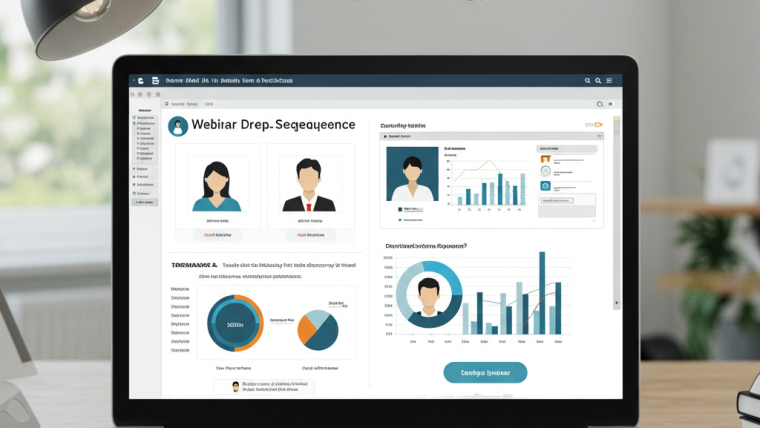Webinars have become one of the most effective tools for digital communication, lead generation, and audience engagement. But the success of a webinar heavily depends on how it is structured. In a crowded digital space, webinars should be formatted in order to hold attention, deliver clear value, and encourage meaningful interaction.
Let’s break down why formatting matters, what a strong webinar structure looks like, and how it can enhance viewer experience and conversion rates.
Why Webinar Formatting Matters
In the virtual environment, attention spans are short. Even if your content is outstanding, poor formatting can lead to early drop-offs and low retention. Audiences expect clarity, flow, and interaction. A properly formatted webinar ensures that:
-
The message is delivered without confusion
-
Transitions are smooth and logical
-
Audiences know what to expect and when
A solid structure enhances not just user experience but also your brand’s credibility and effectiveness.
Core Principles Behind Effective Webinar Formatting
Establish a Clear Objective
Every webinar should start with a clearly defined purpose. This sets the tone and scope. Are you educating, pitching a product, or providing updates? Your format must reflect this goal. A Q&A-heavy webinar won’t work for product demos, and a sales-focused format won’t fit thought leadership sessions.
For example, educational webinars should allocate more time to structured content delivery, whereas lead-generation webinars may include stronger calls-to-action and interactive elements.
Start With a Strong Opening
First impressions are formed within the first two minutes. That’s why you should begin with a professional introduction:
-
Briefly introduce the host and speaker(s)
-
Mention the topic and what attendees can expect
-
Set expectations for time and participation
Avoid diving into content too quickly or rambling without structure. Hook your audience early by making the topic immediately relevant to their needs.
Optimal Webinar Format: A Proven Structure
While your structure may vary slightly depending on your objective, an effective webinar generally follows this format:
1. Introduction (5–7 minutes)
This is where you establish rapport, explain the purpose, and outline the agenda. Don’t just read off slides—speak directly and naturally. You’re setting the stage for engagement.
Include:
-
A quick welcome and acknowledgment of attendees
-
Speaker bios (brief and relevant)
-
A clear agenda of what’s to come
2. Main Presentation (25–35 minutes)
This is the core of your webinar. Break your content into logical segments and avoid overwhelming your audience with too much information at once. Visuals, examples, and transitions between sections make it easier for attendees to follow.
Key tips for this section:
-
Keep each slide focused on one point
-
Use storytelling to explain key concepts
-
Repeat and reinforce important messages
The longer this section runs, the more important it is to include interactive elements like polls, short questions, or live demos.
3. Engagement Breaks (3–5 minutes interspersed)
To maintain energy and interest, build in brief engagement pauses every 10–15 minutes. These could include:
-
A quick poll
-
A question for the audience to answer in chat
-
A brief recap and check-in
These moments break monotony and pull your audience back in.
4. Q&A Session (10–15 minutes)
Allocate time at the end for live questions. This turns a monologue into a conversation. It also shows you value audience input.
Manage this session effectively by:
-
Preparing answers for anticipated questions
-
Prioritizing questions relevant to the majority
-
Managing time carefully to cover the best ones
This section also helps establish authority and build trust.
5. Call-to-Action and Wrap-Up (3–5 minutes)
End with clarity. Reiterate your key message and guide attendees on what to do next. Whether that’s signing up for a product, downloading a guide, or booking a consultation—make the action obvious and simple.
Include:
-
A strong, specific CTA
-
A link or visual showing the next step
-
A thank-you note with contact details or resources
You can also use this moment to invite attendees to explore more about your services. For example, if you’re managing webinars professionally, encourage your audience to visit your homepage for consultation and strategy support.
Avoiding Common Formatting Mistakes
Webinars can fail even with great content if the format is inconsistent or unstructured. Some common issues to watch for include:
-
No time management – Running overtime or rushing through key points kills engagement.
-
Poor transitions – Jumping between sections without guiding the audience confuses them.
-
No interactivity – If your format is too rigid, people tune out quickly.
-
No CTA or follow-up – Many webinars end without giving participants a clear next step.
Fixing these errors is often a matter of applying consistency and strategic breaks to maintain flow.
Tools That Support Effective Formatting
Several webinar platforms now offer features that help automate good formatting. Tools like Zoom Webinar, GoToWebinar, and Demio (outbound link) support agenda setting, polls, and timed segments.
Don’t rely solely on tools, though. Your format must be consciously planned—technology only enhances execution.
Final Thoughts: Format Is the Foundation
In an era where content is abundant but attention is scarce, webinars should be formatted in order to stand out, communicate effectively, and convert leads into clients or followers. Without structure, even the best ideas fall flat.
Take the time to build a clean, logical format tailored to your objective. Whether you’re hosting a single event or running a series, formatting is not optional—it’s foundational.
Want expert support in planning or hosting impactful webinars? Explore our full range of digital event services at LiveCastHub, where we help businesses create results-driven webinar experiences.








Webinar Analytics: A Complete Guide to Measuring Success and Improving Performance
The Ultimate Webinar Follow-Up Strategy to Turn Attendees into Customers
Webinar Accessibility Best Practices: How to Make Your Online Events Inclusive for All
Webinar Personalization: Tailoring Content to Audience Segments for Maximum Engagement